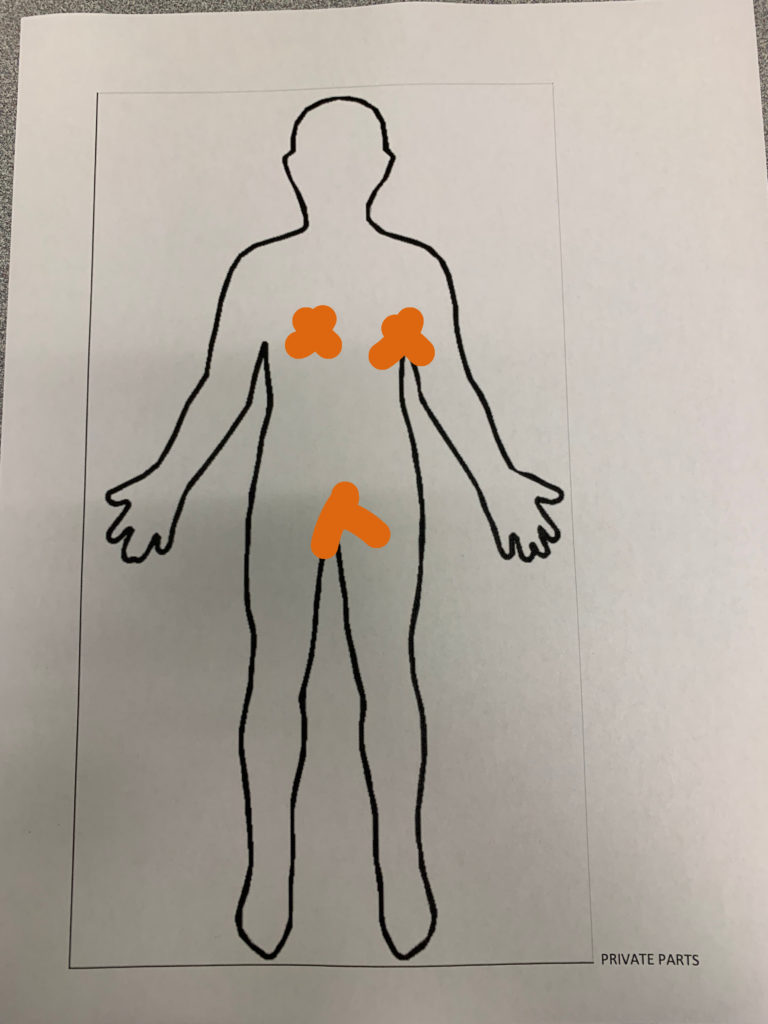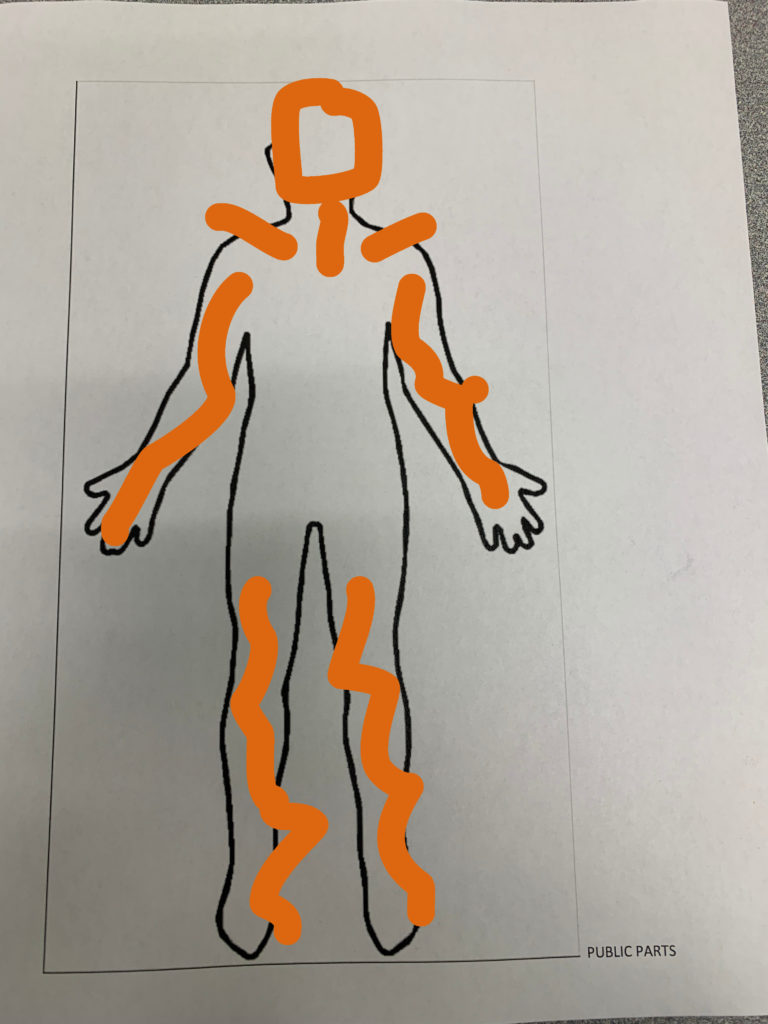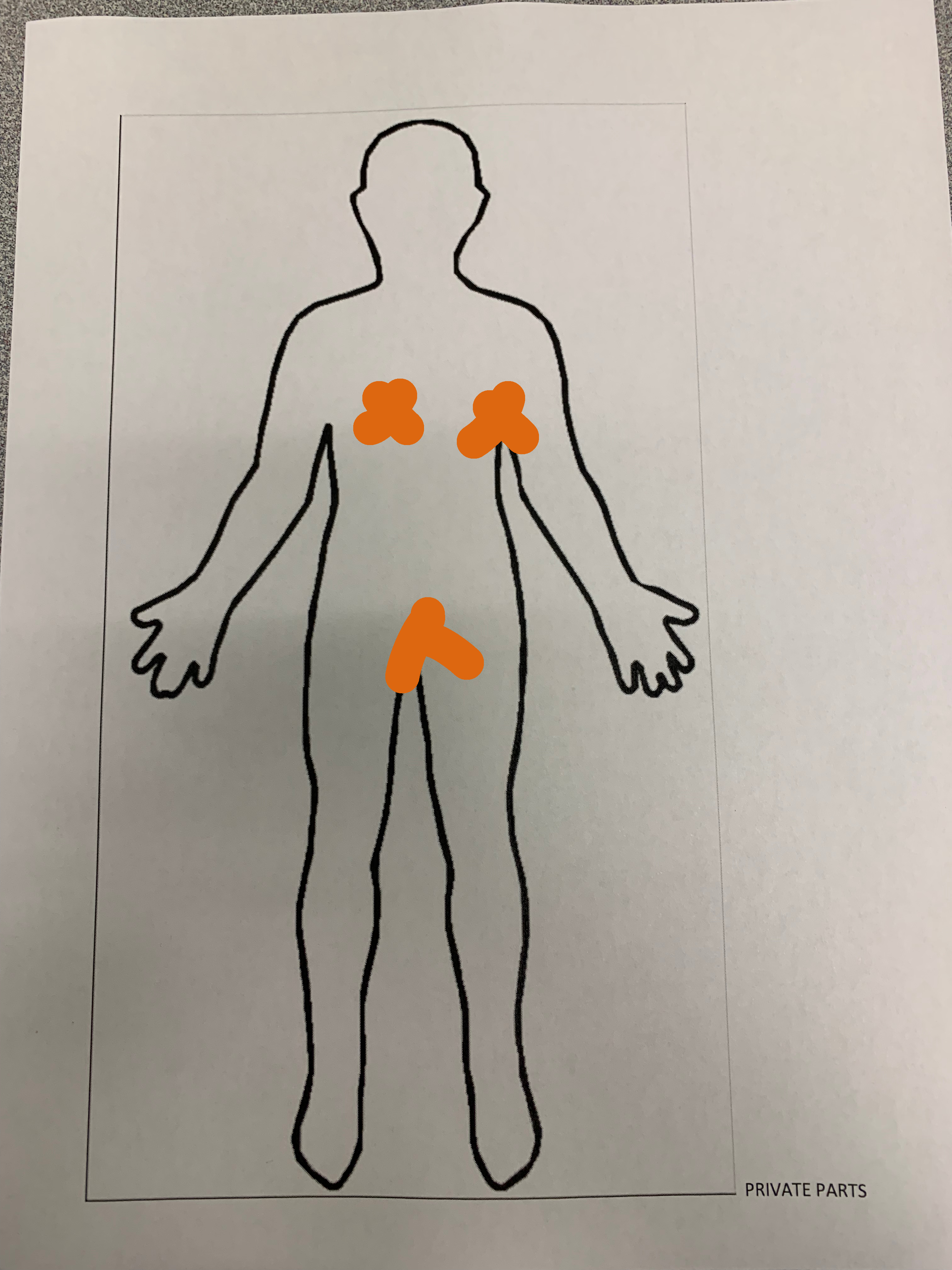Written by Sarah Anderson
This post was written to contribute to the topic of Motherhood and Real Talk for the What Lola Likes blog by Sarah Anderson. All facts, opinions, and professional tips are Sarah’s.
I want to preference this post by saying I understand that talking about sexual abuse and assault with our children can be an uncomfortable topic. It is something we don’t even want to imagine happening to our babies. However, sexual predators do live among us, and it is important that we provide our children with the necessary education, awareness, and tools to protect themselves.
The first step is talking to our children about private and public parts. There are so many ways you can do this. You can start having the conversation during bath time, on the changing table, and when you are dressing your kids. Below is a narrative that you could use, but please feel free to change/modify it however you desire.
For Our Younger Children
Public vs Private Parts
Here is a sample activity that you could use with your child when they reach the age of 3 years. Before this age there are many other ways to have this conversation. I include some ideas later on in this post.
Print out an outline picture of the human body. Have them first label the public parts on the body. Talk about who can see these parts, when/where they can be seen, and who can touch them. Even with public parts, it’s important that our children feel empowered to have a voice as to when and who can touch them.


Then move on to private parts. Have them label or color the areas where our private parts are located. Talk about who is allowed to see them and when. You can even say that bathing suits and underwear cover our private parts, if they are having a hard time remembering the difference between public and private parts. You as your child’s parent, know who are considered safe people and who are not. If you know that grandma will be giving your child a bath and/or changing their diaper/dressing them include grandma as a safe person. You could explain that a doctor may need to look at or touch their private parts, but you or your partner would be in the room if that were to happen. Let them know if anyone were to touch or want to touch their private parts and they felt uncomfortable they need to say no and tell you, your partner, or a trusted adult right away. Tell them that they will never get in trouble for telling the truth. After you finish covering public and private parts ask you child questions to make sure they understand the difference, and who are considered safe people.
I caution you to give a blanket statement of all doctors, or all family members and friends, are safe people. Very often, child predators are those who are close to us, or our children. This information is not meant to scare you, but to inform you.
*(Please note that I would also include the posterior (backside) of the person, not just the anterior (front-side) side).
You can implement this narrative in a variety of ways. You can have your child identify public and private parts on their body or your body. You can have your child identify them on a drawing. Or, you can have your child identify them on a doll, action figure, ect.
I believe this conversation can continue to be had over time. You can change the language as your child gets older. As they age, you can start asking them who they consider safe people, and in what situations it is safe for those people to see and/or touch their private areas. Having your child use the correct anatomic terms for their private parts, such as penis and vagina, can potentially make them less vulnerable to child predators.
Great books on sexual abuse prevention for children:
- I Said No! -By Kimberly and Zack King (ages 5-10)
- No Trespassing – This is MY Body! -By Pattie Fitzgerald (ages 3-7)
- Some Secrets Should Never Be Kept – By Jayneen Sanders (ages 4-8)
- Good Pictures and Bad Pictures- Kristen A. Jenson, MA and Gail Poyner, PhD (ages 5-10)
- Your Body Belongs to You– Cornelia Spelman (ages 3-8)
- Gorp’s Secret- by Sherri Chessen and Karla Olson (ages 3-7)
Talking to Adolescents & Teens
Now, when it comes to talking with teens, there are so many different ways to have the conversation, especially depending on your parenting style and philosophy.
Here are the conversations I consider most important with this age group.
- Safety on social media
- How to detect if a situation is safe or unsafe with an adult or peer
- What to say and do in an unsafe and/or uncomfortable situation
- That you and your partner are nonjudgmental and safe people to come to no matter the situation. You will always believe and support your child.
To address number one, have the discussion with your child on communication safety on Facebook, Instagram, Twitter, ect. Many child predators pretend to be children on the internet. Have the conversation that if anyone ever asks for pictures, personal information, where they live, or to meet them in person to notify you right away (again let them know they will never get in trouble for doing so). As uncomfortable as this next part will be, it is also important to know. If someone under 18 shares a naked picture with another person via, text, email, ect., they are distributing child pornography. For the person receiving the picture, they are now in possession of child pornography. Make sure your adolescent and/or teen knows this. You can explain it in whatever way you feel is best, but many people are unaware of how dangerous this can be. Having discussed this topic with many adolescents and teens I think the number one most important thing is them knowing that their parents are supportive of them, no matter the situation. If they feel like they will get in trouble they won’t come to you.
For numbers two and three you can have a more open conversation with your child. As long as you remain non-judgmental and comfortable with the conversation, your child will be able to be honest and open in the conversation. When it comes to detecting unsafe people and unsafe situations it is really a mix between knowing and understanding who is and what is safe, and also your child trusting their gut and feelings within their body. Sexual predators can often be trusted well-respected individuals within the community. Just because a person may seem safe does not mean they are. Empowering your child to know that their body is there’s, and no one should be touching it without their consent. If they feel uncomfortable, for any reason, they should leave (remove themselves from the situation) and call you immediately.
As I stated above, number four is probably one of the most important conversations to have. Telling your child that no matter the situation or how they got there, you will always support them and believe them if they come to you. Let them know they will never get in trouble or be punished for telling the truth. And add, nothing bad will happen to you or your partner by your child telling you (this can sometimes be a tactic used by child predators).
How and Why I have Started the Conversation with My Daughter
I know that my daughter is only four months old, but I have already started having conversations during bath time and when I change her diaper. I realize that she doesn’t understand what I am saying, but I want these types of conversations to be easy as she gets older. I want her to grow up having confidence and to feel empowered if a situation where to arise that put her at risk for sexual abuse.
Now I want to share with you all a very personal story. To respect those involved I won’t be sharing details of who was involved, where it happened, or at what specific age these events occurred. All names have been changed.
As a child I had a friend whose parent went to prison for child sexual molestation. I was in elementary school when this happened. I remember the day (so vividly) my mother sat me down at the kitchen table and ask me if Bob had ever made me feel uncomfortable when I was at Lucy’s house. I told her yes all the time. She then asked me if he ever touched me. I said no. Whenever Lucy’s mother was gone and we were home alone with Bob I would never leave myself alone with him. He always made me feel incredibly uncomfortable. I can still remember the way he would look at me or touch my shoulders when Lucy’s mother was not around. Now knowing what I know, he knew I was not vulnerable enough. I was such a chatterbox and couldn’t keep a secret to safe my life. Because of this, I was protected.
I hope this post helps to make the conversation a little easier for all of you. I will be including videos on this topic on my IG at theetranquilmama.com, as well as additional resources (books, links to online worksheets, ect.). If you have questions please do not hesitate to reach out!

SARAH ANDERSON
Dr. Sarah Anderson, OTD, OTR/L, is a pediatric & mental health occupational therapist at a local Arizona child advocacy center, faculty member at Midwestern University, founder and owner of The Tranquil Mama, and most importantly, mama to her baby girl Penelope. She has extensive experience working with children and their families in the areas of attachment, emotional literacy, emotional regulation, self-regulation, and stress-management. As part of her job she frequently has discussions with children on the topic of sexual abuse prevention. Due to the nature of her job, these conversations often happen after the fact. It is her goal to spread awareness and provide training for parents on how to have these conversations at home.
VISIT HER PAGE.
